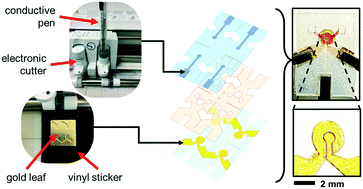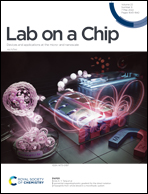Low-cost and rapid prototyping of integrated electrochemical microfluidic platforms using consumer-grade off-the-shelf tools and materials†
Abstract
We present a low-cost, accessible, and rapid fabrication process for electrochemical microfluidic sensors. This work leverages the accessibility of consumer-grade electronic craft cutters as the primary tool for patterning of sensor electrodes and microfluidic circuits, while commodity materials such as gold leaf, silver ink pen, double-sided tape, plastic transparency films, and fabric adhesives are used as its base structural materials. The device consists of three layers, the silver reference electrode layer at the top, the PET fluidic circuits in the middle and the gold sensing electrodes at the bottom. Separation of the silver reference electrode from the gold sensing electrodes reduces the possibility of cross-contamination during surface modification. A novel approach in mesoscale patterning of gold leaf electrodes can produce generic designs with dimensions as small as 250 μm. Silver electrodes with dimensions as small as 385 μm were drawn using a plotter and a silver ink pen, and fluid microchannels as small as 300 μm were fabricated using a sandwich of iron-on adhesives and PET. Device layers are then fused together using an office laminator. The integrated microfluidic electrochemical platform has electrode kinetics/performance of ΔEp = 91.3 mV, Ipa/Ipc = 0.905, characterized by cyclic voltammetry using a standard ferrocyanide redox probe, and this was compared against a commercial screen-printed gold electrode (ΔEp = 68.9 mV, Ipa/Ipc = 0.984). To validate the performance of the integrated microfluidic electrochemical platform, a catalytic hydrogen peroxide sensor and enzyme-coupled glucose biosensors were developed as demonstrators. Hydrogen peroxide quantitation achieves a limit of detection of 0.713 mM and sensitivity of 78.37 μA mM−1 cm−2, while glucose has a limit of detection of 0.111 mM and sensitivity of 12.68 μA mM−1 cm−2. This rapid process allows an iterative design–build–test cycle in under 2 hours. The upfront cost to set up the system is less than USD 520, with each device costing less than USD 0.12, making this manufacturing process suitable for low-resource laboratories or classroom settings.



 Please wait while we load your content...
Please wait while we load your content...